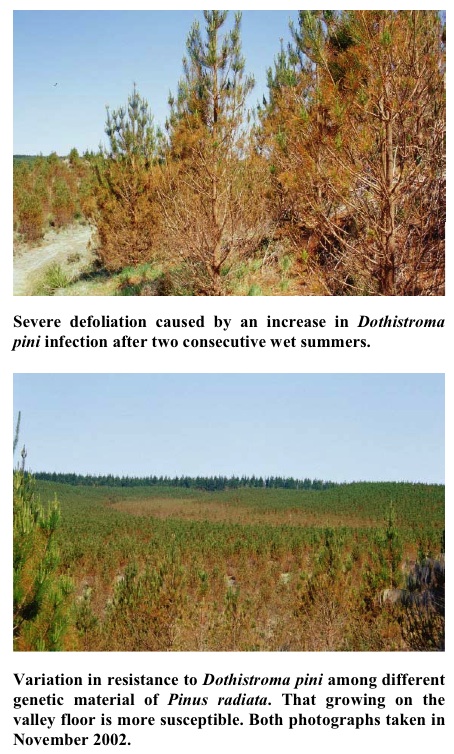PESTS AND DISEASES OF FORESTRY IN NEW ZEALAND
Dothistroma on the increase
Scion is the leading provider of forest-related knowledge in New Zealand
Formerly known as the Forest Research Institute, Scion has been a leader in research relating to forest health for over 50 years. The Rotorua-based Crown Research Institute continues to provide science that will protect all forests from damage caused by insect pests, pathogens and weeds. The information presented below arises from these research activities.
from Forest Health News 124, November 2002.
Severe defoliation caused by Dothistroma pini has been recorded in pine plantations in many parts of the country this year. Approximately 180,000 ha will be sprayed in the 2002/03 season, compared with about 60,000 ha in 2000/01 and 100,000 ha in 2001/02.
 Three factors govern infection – temperature, leaf wetness period, and the amount of inoculum. The main infection period is from November to February when temperatures are optimal for disease development. Regions where Dothistroma needle blight is currently significant experienced two consecutive wet summers in 2000/01 and 2001/02, in terms of both total rainfall and number of rain days. The wet weather coupled with suitable temperatures and increasing inoculum has resulted in very high disease levels.
Three factors govern infection – temperature, leaf wetness period, and the amount of inoculum. The main infection period is from November to February when temperatures are optimal for disease development. Regions where Dothistroma needle blight is currently significant experienced two consecutive wet summers in 2000/01 and 2001/02, in terms of both total rainfall and number of rain days. The wet weather coupled with suitable temperatures and increasing inoculum has resulted in very high disease levels.
Delays to spraying last year because of the unsettled weather have compounded the problem. Forest owners are making every effort to ensure that aerial spraying for the control of Dothistroma is done on time this season and are no doubt hoping for a dry
summer.
The Dothistroma Control Committee has commissioned an aerial spray trial to be carried out by Forest Research that will examine the effect of reducing the amount of spray oil used in the spray formulation. Spray oil is a significant component of the spray cost and if quantities used can be reduced without loss of efficacy considerable savings can be made. The trial, which will also test some new copper formulations provided by two manufacturers, will be carried out in late November.
(Lindsay Bulman, Forest Research)
This information is intended for general interest only. It is not intended to be a substitute for specific specialist advice on any matter and should not be relied on for that purpose. Scion will not be liable for any direct, indirect, incidental, special, consequential or exemplary damages, loss of profits, or any other intangible losses that result from using the information provided on this site.
(Scion is the trading name of the New Zealand Forest Research Institute Limited.)

 Farm Forestry New Zealand
Farm Forestry New Zealand

